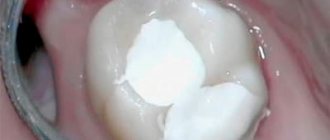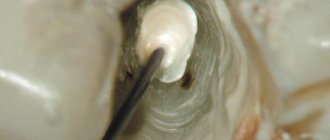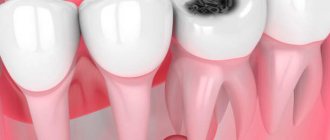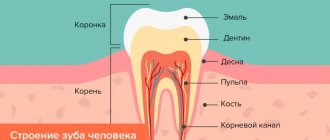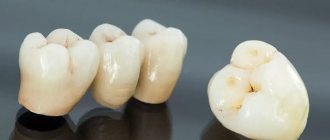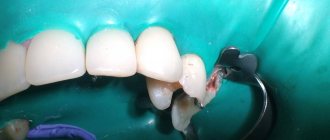Often toothache is possible under a temporary filling after the medication is installed. So if you are one of those people who develop the disease into a chronic form due to reluctance or inability to visit a doctor on time, be prepared for the fact that medications will not immediately relieve you of pain symptoms. And don’t expect a miraculous recovery in one visit to the dentist.
In the presence of such serious diseases as pulpitis, periodontitis, deep caries, the installation of medications is often simply inevitable. All that remains is to take painkillers and wait until your next doctor’s appointment.
In general, it is believed that the presence of pain in the first couple of days after the installation of a temporary composite is an acceptable norm, because this time falls at the very peak of the effect of the drugs. The nerve endings in the tooth pulp have not yet lost sensitivity and react to the mummifying dissolving paste. The pain may simply be caused by the drug. However, if your tooth hurts after a temporary filling, when the treatment is completed and some time has passed since your last visit to the doctor, there is a real reason for concern. After all, such pain can be caused by incorrect actions of a specialist, an incorrectly installed filling, untreated or renewed inflammation, complications and a number of other reasons. In such a situation, it’s time to sound the alarm and urgently run to your dentist.
Symptoms of needing root canals
If you experience prolonged pain from cold or hot water, lasting several minutes, you should suspect inflammation of the nerve in the tooth. The pain can increase gradually, occur after a filling is placed, or with severe tooth decay due to a cold, decreased immunity, stress, or hypothermia. If pain occurs when food hits a certain tooth, when you press on it or tap it with a spoon, then you can assume inflammation of the apical tissues around the root - periodontitis. Cleaning the canals, treating them with medication and filling them is necessary to prevent the spread of inflammation to neighboring areas. In severe cases, complications such as periostitis, osteomyelitis, abscess or phlegmon develop, the latter is treated in a hospital. If the nerve or gangrenous tissue from a tooth is not removed in time, the risk of losing the tooth itself increases over time.
A tooth hurts under an old filling: when do you need help from a dentist?
If the pain does not subside, you cannot do without a visit to the clinic. To make a correct diagnosis, the dentist needs to know all the symptoms associated with pain. The further method of treatment depends on the condition of the teeth and adjacent tissues. As a rule, the previous filling is removed, treated with antiseptics, and the canals are cleaned and sealed again.
After dental surgery, it is imperative to follow the doctor’s recommendations. They speed up the healing process and prevent new inflammations from developing. After applying the filling, it is not recommended to drink alcoholic beverages or excessively hot or cold food. Avoid sweets and solid foods. For the first two days, it is recommended to eat only soft foods and rinse your mouth after eating. Chew on the opposite side of the filled tooth for three days. You should brush your teeth gently and without pressure.
Even if the pain was there but has subsided, you should not postpone your visit to the clinic. Inflammatory processes may continue, and the pain will certainly return with even greater force.
Pain after nerve removal and root canal treatment
One of the most common misconceptions among patients is that a tooth without a nerve cannot hurt. In principle, there is truth in this. But it's not that simple. Nerve fibers exit the tooth through the apical foramen in the root and unite into common trunks, thicker and more powerful. Such a trunk may be responsible for the sensitivity of the entire half of the jaw or face. This explains the irradiation (passage) of pain along the entire nerve if the inflammation affects only one tooth. The impulse is transmitted through nerve fibers to neighboring areas - ear, temple, eye, eyelid, forehead, etc. When a nerve is removed (tooth depulpation), it is simply torn off from the main trunk, causing inevitable injury to the tissues. Canal cleaning takes place under anesthesia and the patient does not feel the moment the instrument exits through the tooth. Without proper control over this procedure, a hematoma (local hemorrhage) may form in the area of the apex of the tooth root, which will cause pain when pressing on the tooth or clenching the jaws. A feeling of mild pain in a pulpless tooth is acceptable for 1–2 days. As a rule, with high-quality cleaning of the contents of the tooth cavity, there is no painful reaction from temperature stimuli (cold or hot water), no severe throbbing or aching pain. If the doctor removed the nerve from the tooth, treated the canals and left a turunda with an antiseptic in them, the tooth should not hurt. If, some time after treatment, the patient notices severe pain, which intensifies in the evening or at night, it is necessary to re-clean and rinse the root canals. This needs to be done as quickly as possible; you should not endure the pain or relieve it with medications. Short-term help can be provided by painkillers: Pentalgin, Ketanov, Tempalgin and others.
The occurrence of throbbing pain from hot water after root canal filling
Treatment of tooth canals involves not only treating, cleaning and drying them, but also filling them with special filling materials. As a rule, pastes for these purposes are used with or without anti-inflammatory additives. Filling the canals is necessary in order to eliminate the possibility of creating conditions for the growth of bacteria. When the tooth cavity is densely filled with gutta-percha pins and paste, there are no such conditions. If some of the infected tissue gets behind the root apex during canal treatment, the inflammation spreads to the bone. Pain in the tooth appears almost immediately after root canal treatment or during the first days and has a certain character: pulsating, twitching, shooting, aggravated by heat. In order to eliminate such a complication, it is necessary to carefully treat the tooth canals using the correct technique. If such pain occurs, it is necessary to re-treat the canals; a short-term effect is achieved by taking painkillers with an anti-inflammatory effect: Nise, Ibuprofen. In some cases, rinsing the mouth with a warm soda solution (1 teaspoon of salt and soda per glass of water) has a positive effect.
A tooth hurts under a filling when pressed: reasons
The main reasons why a tooth under a filling may hurt when pressed:
- Medical error. The canals were treated poorly during dental surgery or the filling does not completely cover the damaged enamel.
- Lack of hygiene. Neglect or poor brushing of teeth after eating, chewing hard foods with teeth with fresh fillings.
- Worn filling. On average, the protective properties of a filling last for 5 years. Then the protection begins to weaken and needs to be replaced.
- Error during filling. The material of modern fillings contains a significant amount of chemical elements. And such a composition can cause an allergic reaction in the patient. It manifests itself gradually, first of all, the feeling of discomfort intensifies, aching pain occurs, and the inflammatory process begins.
- Pulpitis develops under the filling. The long process of caries development leads to the development of inflammation. In this case, pain occurs constantly. The disease progresses quickly and can lead to tooth loss, so you should not hesitate to visit the dental clinic.
- Apical periodontitis. The inflammatory process develops due to the lack of timely treatment. Pain occurs when pressing on the tooth.
Pain in the tooth after canal treatment, if there is a focus of inflammation in the bone
If a patient comes in with pain that intensifies when food hits the tooth, with a feeling of internal pressure from inside the tooth, almost always in such cases there is inflammation in the bone or around the root. This situation occurs when the nerve is destroyed, rots and the entire infection comes out of the tooth into the bone, forming an inflammatory focus - a cyst or granuloma. Treatment in this case is quite complicated, and the tooth cannot always be saved. If the doctor believes that there is a chance to cure the inflammation, he treats the root canals and leaves turunda with an anti-inflammatory solution or medicinal paste in them under a temporary filling for 1–2 weeks, after which he fills the canals with permanent hardening materials. In some cases, the pain does not go away immediately. Therapeutic agents gradually take effect, so the first few days after treatment the tooth may hurt. As a rule, in such cases, additional treatment is prescribed in the form of anti-inflammatory tablets (Nise, Ibuprofen), antibiotics (Amoxiclav, Lincomycin) or antimicrobial agents (Trichopol). Rinsing with warm soda solution helps relieve pain.
There is no need to be afraid of root canal treatment and nerve removal. Modern pain relievers will effectively help you carry out the entire procedure without any pain. Mechanical preparation of hard tissues, cleaning of the tooth cavity, treatment and filling of root canals are necessary procedures, but they should be carried out in compliance with all the rules. High-quality root canal treatment is the key to tooth preservation.
Composition of temporary filling
The main difference between temporary fillings and permanent fillings is their composition. They are usually made from the following materials:
- Artificial dentin. This is a mixture of zinc oxide and sulfate powders with distilled water.
- Vinoxol. It is a mixture of zinc oxide powder and liquid. It has good adhesion and antiseptic properties, and due to its high strength, a temporary filling made from this material can last up to six months.
- Dentine paste. White homogeneous mass with essential oils. The material is plastic, has excellent adhesion, and has water-repellent properties.
- Zinc-eugenol cement. It contains zinc oxide and clove oil or the fragrant substance eugenol. A temporary filling made from this material has good adhesion, an analgesic effect, antiseptic properties, and resistance to increased loads.
- Polycarboxylate cement. It is a mixture of zinc oxide powders, copper and liquid. It has good ductility, resistance to moisture, and excellent adhesion.
- Karyosan - zinc oxide with eugenol.
All materials have their own hardening time and the period after which food can be eaten. For each case, the dentist himself determines the type and composition for filling the cavity, which will affect the price of the temporary filling.
Causes of an unpleasant reaction after treatment
If you put a medicine inside the canal, then its cavity was first mechanically processed.
During root space cleansing:
- the living vascular bundle with nerves is removed;
- or if it is no longer there, then non-viable tissue remains.
If you are prescribed medicine for a toothache, you need to pay attention to the intensity of its response. Because treatment of the root lumen is an operation with some impact on the internal structure, and after it there may be an unpleasant sensation as a reaction to a damaging influence.
And the medicine itself has its effect for the first 2-3 days, slightly irritating the inner surface. And if inflammation exists before the operation to insert the canal into the space, after putting in the pharmaceutical agent, the fact that the tooth hurts with the medicine will also be normal. After all, it will not immediately stop responding to an existing infection even after measures to eliminate it. This will take some time. And for the product inside to have its effect, a certain period of time must also pass.
It is necessary to pay attention to the unpleasant sensations that arise and how they manifest themselves. If you put the medicine in the tooth, it hurts very much and a pulsating reaction appears, it means that the cause has not been completely eliminated, and the inflammation has intensified.
We put medicine on a tooth and it hurts, how to distinguish the reaction
Let's look at what can be put inside the root space:
- When it is necessary to remove a nerve, a pulp necrotizing agent (arsenic-based) is used. In modern versions, an anesthetic is added and there should be practically no reactions from the chewing element.
- If the neurovascular bundle is removed, calcium hydroxide-based materials are placed. It prevents the conditions for the viability of bacteria and at the same time has a reparative effect on periodontal tissue so that they can recover. In this case, it may be that when you put the medicine in the tooth it hurts and you feel discomfort while biting. The reaction normally lasts from 10 to 14 days, gradually decreasing.
If you put medicine in the tooth and it hurts, a pulsating reaction appears, you need to see a dentist. Since the cause may be increased inflammation or a reaction to the installed material, and they need to be eliminated.
When to see a doctor
If the pain does not decrease and does not go away within the time allotted for it according to the protocol, you should go to the doctor immediately. Without doing this, you will provoke serious complications that will lead to protracted and difficult to eliminate consequences.
Important! Especially if, after root canal filling, the gums are swollen and the pain increases, you should contact your dentist immediately.
If your gums are swollen, you should immediately contact your dentist.
To find out the cause of the pain, the specialist will conduct a palpable examination, tap the tooth (percussion), determine the viability of the pulp using electric current (ED) and prescribe x-ray diagnostics. If errors in treatment are identified or other causes of pain are discovered, the tooth must be re-treated. In emergency cases, when it is not possible to treat the tooth, it will be removed and a crown implant, bridge structure, or other recommended prosthesis will be installed in its place.
Crown on an implant
